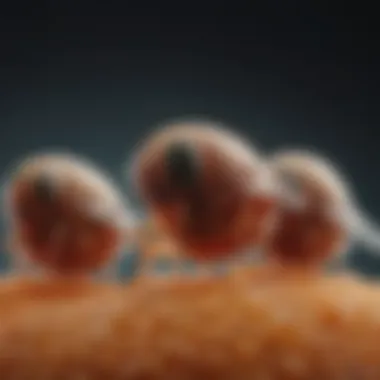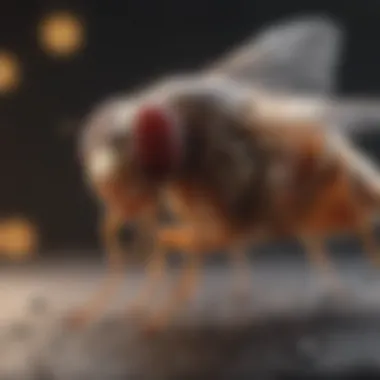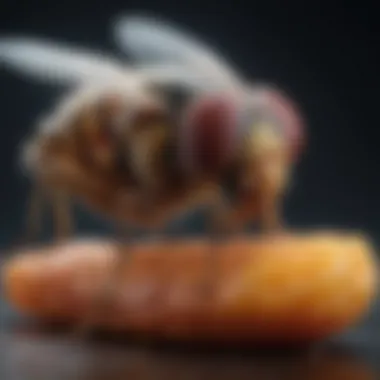Unveiling the Fascinating Lifespan Journey of a Fruit Fly: From Egg to Adulthood


Animal Species Profile
Lifespan and Developmental Stages
Upon hatching from eggs, fruit flies progress through distinct developmental stages: egg, larva, pupa, and adult. The egg stage lasts for about 1 day before transforming into larvae, which undergo multiple molts to grow in size. Subsequently, pupation occurs, signifying the transition into adulthood. The adult fruit fly typically lives for 20 to 30 days, during which it focuses on mating and laying eggs. The concise but potent existence of fruit flies offers a window into understanding genetics, aging processes, and life expectancy research.
Genetic Significance and Research Impact
Fruit flies play a pivotal role in genetic studies due to their short lifespan and rapid reproductive rate. Researchers have been able to map out their entire genome, uncovering essential insights into gene functions and inheritance patterns. By manipulating genetic mutations in fruit flies, scientists can observe the effects on various traits and behaviors, shedding light on human genetic disorders and evolution. This symbiotic relationship between human genetic research and fruit fly studies unveils valuable information that aids in medical breakthroughs and technological advancements.
Environmental Factors and Adaptations
The adaptability of fruit flies to various environmental conditions is a testament to their survival prowess. These insects possess remarkable physiological adaptations that allow them to thrive in changing environments. Their ability to withstand fluctuations in temperature, humidity, and food sources reflects their evolutionary resilience. Understanding the genetic basis for these adaptations not only elucidates fundamental biological processes but also holds potential applications in fields like agriculture, pest control, and environmental conservation.
Conclusion
Introduction
Overview of Fruit Flies
Basic Characteristics
Embarking on a journey through the basic characteristics of fruit flies, we uncover fundamental traits that make them a cornerstone in genetic and biological studies. The resilience and adaptability of fruit flies make them ideal subjects for research due to their rapid reproductive cycle and well-defined genetic makeup. Their small size and ease of cultivation enhance their suitability for laboratory experiments, offering researchers a compact but highly informative model organism to dissect intricate genetic mechanisms.
Importance in Research
Exploring the profound importance of fruit flies in the realm of scientific research unveils a tapestry of contribution towards expanding our knowledge across various fields. From deciphering genetic mutations to understanding developmental processes, fruit flies have played a pivotal role in shaping modern biology. Their ability to provide actionable insights into intricate biological phenomena and genetic pathways has positioned them as invaluable assets in laboratories worldwide.


Genetic Similarities to Humans
Analyzing the genetic similarities between fruit flies and humans provides a significant platform for uncovering shared biological processes and evolutionary links. Despite the evolutionary distance between the two species, fruit flies exhibit conserved genetic pathways that parallel key aspects of human biology. By leveraging these similarities, researchers can gain crucial insights into human genetic disorders, aging processes, and potential therapeutic interventions.
Purpose of Study
Understanding Lifespan
Embarking on a quest to unravel the mysteries surrounding lifespan, this section delves into the significance of understanding the factors that influence the duration of life in fruit flies. By dissecting the intricate interplay between genetics, environment, and biological processes, researchers aim to decode the fundamental mechanisms governing lifespan in this model organism. The study of lifespan offers a window into broader questions of longevity, healthspan, and age-related diseases, providing a foundation for future research directions.
Investigating Aging Processes
Peering into the intricate web of aging processes within fruit flies unveils a complex landscape shaped by genetic and environmental factors. By investigating the molecular mechanisms underpinning aging, researchers aim to decipher the key drivers of senescence and longevity in this organism. The study of aging processes offers a lens into fundamental biological pathways that influence lifespan, paving the way for enhanced understanding of age-related diseases and potential interventions.
Implications in Genetic Studies
Exploring the implications of fruit fly studies in genetics opens a gateway to uncovering novel insights into genetic inheritance, mutations, and hereditary traits. By leveraging the genetic tools and resources available in fruit fly research, scientists can manipulate gene expression, model human diseases, and uncover hidden facets of genetic variation. The implications of genetic studies in fruit flies extend beyond the laboratory, offering a roadmap for translating basic research findings into practical applications in fields ranging from medicine to agriculture.
Life Cycle of Fruit Flies
The Life Cycle of Fruit Flies section serves as a fundamental element in dis -cussing the captivating narrative of these tiny beings' existence. Examining the Life Cycle of Fruit Flies allows a meticulous observation of their holistic development, from vibrant eggs to bustling adulthood. This pivotal section sheds light on the intricate stages - Egg, Larval, Pupal, and Adult - that shape the essence of the Fruit Fly lifecycle, each phase orchestrating a symphony of growth and transformation unique to these miniscule marvels of nature.
Egg Stage
In delving into the Egg Stage, one uncovers the genesis of a Fruit Fly's life, where the fascinating journey initiates with the impeccable process of fertilization. The Fertil -ization Process marks the commencement of life as we trace the formation of these tiny embryos that hold the genetic blueprint of future generations. This aspect holds utmost significance in elucidating the hereditary traits that evolve through each progeny, influencing research in genetics and heredity studies fundamentally.
Comple -menting the Fertilization Process is the intriguing Egg Development Timeframe, where the ticking biological clock orchestrates the metamorphosis from a mere speck to a full-fledged egg ready to embark on the transformative journey of life. The timeframe intricately governs the embryonic development, encapsulating critical phases that culminate in the birth of a Larval stage Fruit Fly, palpably enriching the narrative of their lifecycle preciously.
Larval Stage


Transitioning to the Larval Stage unravels a realm of voracious appetite and relentless growth in a Fruit Fly's lifespan. The Growth and Feeding Habits featured in this stage explore the insatiable hunger and rapid physical transformations the larvae undergo as they gorge on sustenance to fuel their burgeoning bodies. This aspect intricately ties with the Molting Cycles that punctuate the Larval experience, signifying pivotal stages of shedding exoskeletons to accommodate escalating growth pressures with each lifecycle, symbolizing resilience in adaptation and evolution amidst environmental dynamics.
Pupal Stage
Embarking on the Pupal Stage brims with the enchanting metamorphic spectacle of Fruit Flies transmuting from voracious larvae to dormant pupae awaiting their grand emergence. The Metamorphosis Process orchestrates a graceful enactment of cellular reorganization and tissue remodeling, sculpting the pupae into miniature replicas of their imminent adult forms, embodying the essence of regeneration and resilience imprinted in nature's artistic design.
Complementing this poignant transformation is the Pupal Development Period, a period doused in mystery and transformation where time dances on the precipice of profound change. This period encapsulates the subtle nuances of internal restructuring and growth unseen to the naked eye, defining the course of adulthood that looms on the horizon, imbuing the pupal phase with a sense of eager anticipation and latent potential waiting to unfurl in due time.
Adult Stage
The pinnacle of a Fruit Fly's journey culminates in the Adult Stage, where the encompassing Reproductive Phase unveils the prime objective of existence in procreation and perpetuation of the species. This pivotal stage embodies the primeval dance of life's perpetuation, showcasing the intricate courtships, mating rituals, and the eventual legacy of progenies passing on genetic imprints to future generations, signifying the eternal cycle of creation imprinted in the very core of existence.
Concluding this orchestral journey is the contemplation on Life Span, the transient period that encapsulates the ephemeral yet impactful existence of a Fruit Fly. The life span represents a kaleidoscope of moments, from exuberant blossoming youth to the dignified grace of aging adulthood, each heartbeat echoing the resilience, adaptability, and relentless spirit ingrained in every flight of a Fruit Fly, showcasing the profound nature of life in its fleeting yet impactful essence.
Factors Influencing Lifespan
In exploring the fascinating topic of Factors Influencing Lifespan in the context of fruit flies, we delve into crucial aspects that shape the existence of these remarkable insects. Understanding the intricate interplay between genetic and environmental factors offers profound insights into the nuances of lifespan regulation in these tiny creatures. By dissecting the genetic and environmental determinants of longevity in fruit flies, we unlock a treasure trove of knowledge that reverberates beyond their diminutive size, echoing implications for broader studies in genetics, aging, and biological research.
Genetic Factors
Inherited Traits
Discussing the pivotal role of Inherited Traits in shaping the lifespan of fruit flies opens a gateway to comprehension on the hereditary influences that govern longevity. These inherent genetic characteristics carry significant weight in determining how long a fruit fly lives and how it responds to various environmental stimuli. By scrutinizing the heritability of traits related to aging and longevity in fruit flies, we unravel a tapestry of genetic intricacies that underpin the mechanisms driving lifespan extension or reduction. The unique genetic signatures embedded in Inherited Traits lend credence to their paramount importance in unraveling the mysteries of longevity in these miniature organisms, making them a focal point in the study of fruit fly lifespan dynamics.
Mutations Impact
Embarking on a discourse surrounding Mutations Impact shines a spotlight on the disruptive yet informative role mutations play in shaping the lifespan of fruit flies. Mutations, whether spontaneous or induced, introduce a paradigm shift in the genetic landscape of these insects, altering their susceptibility to environmental stressors and influencing their longevity potential. By deciphering the impact of mutations on lifespan and aging processes in fruit flies, we gain valuable insights into the plasticity and adaptability of their genetic makeup. The distinctive attributes of Mutations Impact, characterized by both advantageous adaptations and detrimental repercussions, underscore their significance in delineating the multifaceted intricacies of genetic influences on fruit fly lifespan regulation.


Environmental Factors
Temperature Effects
Exploring the implications of Temperature Effects on fruit fly lifespan unravels a compelling narrative on how external environmental cues can modulate the longevity of these diminutive creatures. Temperature, acting as a vital environmental factor, exerts a profound influence on the metabolic rate, development, and overall survival of fruit flies. Delving into the intricate dance between temperature variations and fruit fly lifespan sheds light on the adaptive responses and physiological adjustments these insects undergo in the face of changing environmental conditions. The distinct impact of Temperature Effects on fruit fly biology underscores the delicate balance between environmental perturbations and physiological resilience, offering a nuanced perspective on the interplay between external conditions and biological outcomes.
Dietary Influence
Examining the profound effects of Dietary Influence on fruit fly lifespan provides a captivating narrative on the critical role nutrition plays in shaping the longevity and healthspan of these resilient insects. Dietary choices, encompassing nutrient composition and caloric intake, stand as pivotal determinants in influencing metabolic pathways, oxidative stress levels, and overall lifespan in fruit flies. By dissecting the intricate relationship between diet and longevity in these organisms, we unravel the intricate links between nutritional quality, biological resilience, and aging processes. The nuanced effects of Dietary Influence on fruit fly physiology underscore the intricate web of interactions between dietary components and genetic predispositions, offering valuable insights into the modifiable factors that impact lifespan and healthspan in these miniature marvels.
Research Significance
Impact on Aging Studies
Delving into the far-reaching Impact on Aging Studies stemming from fruit fly research unveils the transformative potential these insects hold in advancing our understanding of age-related processes and interventions. Fruit flies, serving as powerful model organisms, offer a comprehensive platform for studying the molecular, genetic, and environmental factors that influence aging trajectories and lifespan dynamics. By harnessing the unparalleled genetic tractability and short lifespan of fruit flies, researchers can expedite the discovery of novel therapeutics, longevity promoters, and age-defying interventions with implications for human health. The profound Impact on Aging Studies facilitated by fruit fly research heralds a new era of age-related investigations, bridging fundamental discoveries in aging biology with translational applications aimed at promoting healthy aging and longevity.
Applications in Genetics
Unraveling the myriad Applications in Genetics derived from fruit fly experimentation illuminates the diverse avenues through which these tiny insects shape contemporary genetic research and biotechnological advancements. Fruit flies, characterized by their genetic malleability and amenability to experimental manipulations, serve as ideal models for elucidating fundamental genetic principles and exploring gene function in a dynamic biological context. By tapping into the genetic repertoire of fruit flies, researchers can unravel complex gene interactions, regulatory networks, and evolutionary pathways that underpin diverse biological phenomena. The versatile Applications in Genetics afforded by fruit fly studies transcend disciplinary boundaries, offering novel insights into gene-environment interactions, genetic diseases, and biotechnological innovations that reverberate across scientific disciplines. In summation, the transformative potential of fruit flies in genetics research underscores their irreplaceable role in sculpting our understanding of genetic complexity and biological diversity.
Conclusion
Key Takeaways
Insights into Lifespan
Research Implications
Future Research Directions
Enhanced Genetic Studies
Advanced Aging Research
Delving into advanced aging research paves the way for a deeper comprehension of the aging processes in fruit flies and their broader implications. One key characteristic to emphasize is the nuanced investigation into aging mechanisms and longevity through innovative research methods, providing invaluable insights into age-related phenomena. The unique feature of advanced aging research lies in its ability to dissect aging complexities at a microscopic level, making it a highly beneficial and sought-after choice for elucidating age-related processes in fruit flies. While there might be challenges, the advantages of advanced aging research significantly enhance our understanding of aging processes and lay a solid foundation for future discoveries in this captivating field.







